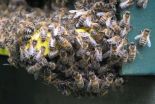(Press-News.org) Why do innocent people go to jail in the United States every year for violent crimes they did not commit? It's a serious question representing the ultimate miscarriage of justice—taking away the freedom of a factually innocent person while also allowing the guilty person to remain free. The U.S. Department of Justice's National Institute of Justice (NIJ) wanted to learn answers to prevent wrongful convictions in the first place.
Jon B. Gould, J.D., Ph.D., a professor and the director of the Washington Institute for Public and International Affairs Research at American University and his team of researchers conducted a three year, first of its kind, large-scale empirical study Predicting Erroneous Convictions: A Social Science Approach to Miscarriages of Justice employing social scientific methods. It was funded by NIJ, and an NIJ video features Gould discussing wrongful convictions. After identifying 460 cases employing sophisticated analytical methods matched with a qualitative review of the cases from a panel of experts, 10 statistically significant factors were identified that distinguish a wrongful conviction from a "near miss" (a case in which an innocent defendant was acquitted or had charges dismissed before trial). "Surprisingly unlike airplane crashes or near midair collisions where the National Transportation Safety Board moves in to investigate and reconstruct events in an effort to prevent future catastrophes, wrongful convictions have rarely been investigated beyond a specific case study," says Gould. "This is especially troubling since our criminal legal system is predicated on finding defendants guilty beyond a reasonable doubt before imprisoning them."
10 Factors Identified in Wrongful Convictions
State death penalty culture/state punitiveness
Strength of prosecution's case
Prosecution withheld evidence (Brady violation)
Forensic evidence errors
Strength of defendant's case
Age of defendant
Criminal history of defendant
Intentional misidentification
Lying by non-eyewitness
Family witness testified on behalf of defendant
The resulting 10 factor model applied by Gould and his team can be used to accurately predict an erroneous conviction versus a "near miss" nearly 91 percent of the time and is a useful tool for jurisdictions around the country to adopt remedies to address the 10 weaknesses with little cost according to Gould. The biggest investment is time, training and the acknowledgement that there is room for improvement from police, prosecutors and defense interests. A key to the model's development was the unprecedented cooperation of an expert panel composed of stakeholders from the Association of Prosecuting Attorneys, Police Foundation, National Innocence Project and National District Attorneys Association.
From the quantitative and qualitative analysis, Gould and his team determined that prevention begins at the police station starting with the interrogation and investigation of alibis. This is followed by several opportunities along the way to identify the innocent before they are wrongfully convicted. For example, if forensic testing was conducted earlier and the results became available sooner to investigators innocent suspects could be freed. But faulty identifications, absence of early forensic test results, and inadequate investigation of alibis leads to what Gould characterizes as a "perfect storm" of errors made worse by collective tunnel vision. It should be noted much of this is unintentional.
The 10 factors in various combinations create this tunnel vision where a prosecutor with a weak case focuses on an accused even more intently rather than considering alternative suspects precisely because tunnel vision has set in – in other words the case seems to add up from the investigation but is sufficiently weak relying on perhaps a misidentification. For Gould this was the most surprising result of his research because he and his team expected strong prosecutorial cases to result in wrongful convictions since the evidence was compelling for the prosecutor to seek conviction but instead the study revealed the contrary. This led the team to look at weak defense counsel, poor explanation/presentation of forensic evidence, and police practices that could trigger the course of events spiraling out of control to a wrongful conviction because the weak prosecution case in turn is not adequately challenged by the defense attorney and the prosecution for one reason or the other may fail to disclose exculpatory evidence- a Brady violation.
Finally, the wrongfully convicted skew toward young suspects as well as those who have a prior criminal record. In other words, the defendants are not in a strong position to demand more from prosecutors or even their own defense counsel because they do not have the wherewithal to challenge the charges.
The study concludes that the social science approach is valid and effective in studying miscarriages of justice and should continue. Gould especially is interested in more research on the "near miss" cases to better learn how the criminal justice system can "get it right" when confronted with an innocent defendant. In the coming weeks, Gould will present his research in Seattle, Miami, New York City, Albany, NY, and North Carolina.
INFORMATION:
American University is a leader in global education, enrolling a diverse student body from throughout the United States and nearly 140 countries. Located in Washington, D.C., the university provides opportunities for academic excellence, public service, and internships in the nation's capital and around the world.
Study reveals 10 factors in wrongful conviction cases
2013-03-13
ELSE PRESS RELEASES FROM THIS DATE:
Punishment can enhance performance, Nottingham academics find
2013-03-13
The stick can work just as well as the carrot in improving our performance, a team of academics at The University of Nottingham has found.
A study led by researchers from the University's School of Psychology, published recently in the Journal of Neuroscience, has shown that punishment can act as a performance enhancer in a similar way to monetary reward.
Dr Marios Philiastides, who led the work, said: "This work reveals important new information about how the brain functions that could lead to new methods of diagnosing neural development disorders such as autism, ADHD ...
Normal prion protein regulates iron metabolism
2013-03-13
An iron imbalance caused by prion proteins collecting in the brain is a likely cause of cell death in Creutzfeldt-Jakob disease (CJD), researchers at Case Western Reserve University School of Medicine have found.
The breakthrough follows discoveries that certain proteins found in the brains of Alzheimer's and Parkinson's patients also regulate iron. The results suggest that neurotoxicity by the form of iron, called redox-active iron, may be a trait of neurodegenerative conditions in all three diseases, the researchers say.
Further, the role of the normal prion protein ...
Ancient Chinese coin found on Kenyan island by Field Museum expedition
2013-03-13
A joint expedition of scientists led by Chapurukha M. Kusimba of The Field Museum and Sloan R. Williams of the University of Illinois at Chicago has unearthed a 600-year-old Chinese coin on the Kenyan island of Manda that shows trade existed between China and east Africa decades before European explorers set sail and changed the map of the world.
The coin, a small disk of copper and silver with a square hole in the center so it could be worn on a belt, is called "Yongle Tongbao" and was issued by Emperor Yongle who reigned from 1403-1425AD during the Ming Dynasty. The ...
Answering messages behind the wheel is as dangerous as being twice over the limit
2013-03-13
Scientists from various Australian universities in collaboration with the University of Barcelona have compared the effects of mobile use while driving with the effects of alcohol using a simulation. Their experiment demonstrates that using a handsfree kit or sending text messages is the same as being above the legal alcohol limit.
The Australian universities of Wollongong, Victoria, Swinburne of Technology, the Institute for breathing and sleep and the University of Barcelona have measured the reaction capacity behind the wheel of twelve healthy volunteers who participated ...
Immune cells cluster and communicate 'like bees,' researcher says
2013-03-13
The immune system's T cells, while coordinating responses to diseases and vaccines, act like honey bees sharing information about the best honey sources, according to a new study by scientists at UC San Francisco.
"In the morning, each bee goes looking individually for a sugar source, then comes back to the hive and does a dance in front of the other bees describing the location of what it's found, which helps the hive decide collectively where the best source is," said senior scientist Matthew Krummel, PhD, a UCSF professor of pathology.
They don't bust the same ...
UT study identifies ways children can meet recommended activity goals
2013-03-13
KNOXVILLE—Despite overwhelming evidence about the benefits of physical activity for children, most American youngsters are not meeting the federal recommendation of 60 minutes a day.
A new study by a team of University of Tennessee researchers has identified specific ways—and estimated minutes for each approach—that can help children achieve the recommended daily physical activity goal.
The results of various approaches, ranging from mandatory physical education in school to changes in playground designs, were published recently in the American Journal of Preventive ...
Polo takes the bait
2013-03-13
KANSAS CITY, MO—A seemingly obscure gene in the female fruit fly that is only active in cells that will become eggs has led researchers at the Stowers Institute for Medical Research to the discovery of a atypical protein that lures, traps, and inactivates the powerful Polo kinase, widely considered the master regulator of cell division. Its human homolog, Polo-like kinase-1 (Plk1), is misregulated in many types of cancer.
Stowers Investigator and senior author R. Scott Hawley, Ph.D., hopes that this highly selective kinase trap might give drug developers, who are working ...
Medicare spending for advanced cancer not linked to survival differences
2013-03-13
Substantial regional variation in Medicare spending for patients with advanced cancer is not linked to differences in survival, according to a study published March 12 in the Journal of the National Cancer Institute.
Cancer care accounts for approximately 10% of Medicare spending, and costs are highest for cancer patients with late-stage disease. Prior research studies have shown that there are large regional differences in spending within the Medicare program, however it is unknown if higher average regional spending for advanced cancer is linked to improved survival ...
Study: Brain imaging after mild head injury/concussion can show lesions
2013-03-13
SAN DIEGO – Brain imaging soon after mild traumatic brain injury (mTBI) or mild concussion can detect tiny lesions that may eventually provide a target for treating people with mTBI, according to a study released today and that will be presented at the American Academy of Neurology's 65th Annual Meeting in San Diego, March 16 to 23, 2013.
Studies of brain tissue once a person has died have shown that different types of lesions are associated with more severe TBI. "Our study suggests that imaging may be used to detect and distinguish between these lesions in a living ...
Preventing HIV infection with anti-HIV drugs in people at risk is cost-effective
2013-03-13
An HIV prevention strategy in which people at risk of becoming exposed to HIV take antiretroviral drugs to reduce their chance of becoming infected (often referred to as pre-exposure prophylaxis or PrEP), may be a cost-effective method of preventing HIV in some settings, according to a study by international researchers published in this week's PLOS Medicine.
In an analysis of 13 modelling studies led by Gabriela Gomez from the Department of Global Health, Academic Medical Centre, University of Amsterdam/AIGHD in The Netherlands, the authors evaluated the impact of pre-exposure ...



